50 X Cardinal Tetras – Paracheirodon Axelrodi – South American Tetras, Stunning Neon Schooling Fish, Perfect Companions for Peaceful Community Aquariums, Thriving in Harmony, Enhance Your Aquarium’s Beauty
£47.49 Original price was: £47.49.£39.99Current price is: £39.99.
Welcome these beautiful Cardinal Tetras into your aquarium! This listing includes 50 individual Paracheirodon Axelrodi, stunning South American Tetras known for their vibrant colors and graceful movements. Perfect companions for peaceful community aquariums, they thrive in harmonious environments.
1862 in stock
Species Introduction
The Cardinal Tetra, scientifically known as Paracheirodon axelrodi, is a captivating freshwater fish native to the Amazon River basin in South America. This species is renowned for its vibrant coloration, featuring a striking blue body complemented by a vivid red stripe that runs along its lateral line. These small fish typically reach a maximum length of about 4 cm (1.5 inches), making them an ideal choice for community aquariums. Cardinal Tetras are often confused with their close relatives, the Neon Tetra (Paracheirodon innesi), but they can be distinguished by their more pronounced red stripe and slightly larger size. Found in slow-moving waters, such as streams and floodplains, Cardinal Tetras thrive in densely planted environments, which provide both shelter and foraging opportunities. As peaceful schooling fish, they are best kept in groups of six or more, allowing them to exhibit their natural behaviors and social dynamics.
Care Requirements Dashboard
| Optimal Living Conditions | |
|---|---|
| Water Temperature | 24-27°C (75-81°F) |
| pH Level | 6.5-7.5 |
| Water Hardness | 4-12 dKH |
| Minimum Tank Size | 80L (20 gal) |
| Salinity | Freshwater |
| Care Level | Beginner Friendly |
✓ Care Level: Easy
Natural Behavior & Temperament
Cardinal Tetras exhibit fascinating natural behaviors that enhance the dynamics of a community aquarium. As schooling fish, they feel most secure and display their vibrant colors when kept in groups of six or more. In their natural habitat, they swim in tight formations, darting in and out of vegetation. This schooling behavior not only provides safety in numbers but also allows for social interactions and displays of dominance among individuals. Their peaceful temperament makes them ideal companions for a variety of other fish species, particularly those that are similarly sized and non-aggressive. They are known to be shy at times, preferring to hide among plants and decorations when feeling threatened. Observing their interactions can be a delightful experience, as they engage in playful swimming and foraging behaviors, showcasing their natural instincts and social structures.
Tank Setup Guide
Creating an ideal environment for Cardinal Tetras involves replicating their natural habitat as closely as possible. A well-planted aquarium with plenty of hiding spots is essential for their comfort and security. Use a substrate that mimics the soft, dark sandy bottoms found in their native waters, and incorporate live plants such as Java moss, Anubias, and floating plants to provide shade and cover. The addition of driftwood and rocks can enhance the aesthetic appeal while offering additional hiding places. Cardinal Tetras prefer dim lighting, so consider using floating plants or a gentle filter to diffuse the light. Ensure that the tank is equipped with a reliable filtration system to maintain water quality, as these fish are sensitive to poor water conditions. Additionally, avoid strong currents, as Cardinal Tetras thrive in calm waters. A well-maintained tank not only supports their health but also encourages natural behaviors, making for a vibrant and dynamic aquatic environment.
Water Quality Management
⚠ Important Water Parameter Notice
Regular monitoring of water parameters is crucial for the health of Cardinal Tetras.
Maintaining optimal water quality is vital for the well-being of Cardinal Tetras. The ideal pH range for these fish is between 6.0 and 7.0, with a temperature range of 22 to 28°C (72 to 82°F). Regular water changes of 25% every two weeks will help to keep ammonia and nitrite levels low, which is essential for preventing stress and disease. Additionally, the water hardness should be kept within a soft to moderately hard range, ideally between 2 to 15 dGH. Using a high-quality water conditioner can help to remove harmful chemicals and chlorine from tap water, ensuring a safe environment for your aquatic companions. It’s also important to monitor the nitrate levels, which should be kept below 20 ppm. A well-maintained tank with stable water parameters will not only keep your Cardinal Tetras healthy but will also enhance their vibrant colors and lively behavior.
Feeding & Nutrition
Cardinal Tetras are omnivorous and thrive on a varied diet that mimics their natural feeding habits. In the wild, they consume small insects, crustaceans, and plant matter. In an aquarium setting, it’s essential to provide a balanced diet that includes high-quality flake food, micro-pellets, and frozen or live foods such as brine shrimp, daphnia, and bloodworms. A varied diet not only promotes optimal growth and coloration but also enhances their overall health. Feeding should occur two to three times a day, with only as much food as they can consume in a few minutes to prevent overfeeding and maintain water quality. It’s important to observe their feeding behavior, as Cardinal Tetras may be timid eaters, especially in a community tank. Ensuring that they receive adequate nutrition will help to prevent health issues and support their vibrant colors and active lifestyle.
Compatibility Guide
Cardinal Tetras are known for their peaceful nature, making them excellent additions to community tanks. They thrive alongside other non-aggressive fish species, such as other tetras, rasboras, danios, and small catfish. However, it is crucial to avoid pairing them with larger or more aggressive fish that may see them as prey. Ideal tank mates include species like the Neon Tetra, Guppies, and Corydoras catfish, which share similar water requirements and temperament. When planning your community tank, aim for a balanced mix of species that occupy different levels of the tank to reduce competition for space and resources. It’s also advisable to introduce new fish gradually and monitor their interactions to ensure a harmonious environment. By carefully selecting compatible tank mates, you can create a vibrant and thriving aquatic community that showcases the beauty and charm of Cardinal Tetras.
Health & Wellness
Maintaining the health and wellness of Cardinal Tetras requires vigilance and proactive care. Common health issues include ich, fin rot, and stress-related ailments, often caused by poor water quality or inappropriate tank conditions. Regular water testing and maintenance are crucial to prevent these problems. Signs of illness may include lethargy, loss of appetite, and abnormal swimming patterns. If you notice any of these symptoms, it’s essential to isolate the affected fish and assess the water parameters. Treatment may involve adjusting the water conditions, administering medications, or improving tank conditions. Additionally, providing a varied diet rich in vitamins and minerals can help to boost their immune system and overall vitality. By prioritizing their health and wellness, you can ensure that your Cardinal Tetras live a long and happy life in your aquarium.
Breeding Information
Breeding Cardinal Tetras can be a rewarding experience for aquarists willing to create the right conditions. These fish are egg layers, and breeding typically occurs in soft, acidic water with a pH of around 6.0 and a temperature of 24-26°C (75-79°F). To encourage spawning, it’s advisable to set up a separate breeding tank with fine-leaved plants or spawning mops where the female can lay her eggs. After spawning, the adult fish should be removed, as they may eat the eggs. The eggs usually hatch within 24 to 36 hours, and the fry will become free-swimming after about five days. During this time, it’s essential to provide infusoria or finely crushed flakes for feeding the fry, as they are too small to consume standard fish food. As they grow, gradually introduce larger food particles. With patience and care, you can successfully breed Cardinal Tetras and contribute to the preservation of this beautiful species.
Acclimation Process
The acclimation process is crucial for ensuring the well-being of your new Cardinal Tetras as they transition to their new home. Upon receiving your fish, it’s important to allow them to adjust to the water conditions of your aquarium gradually. Begin by floating the sealed bag containing the fish in your tank for about 15-20 minutes to equalize the temperature. After this, slowly introduce small amounts of your tank water into the bag over the course of an hour. This gradual mixing helps the fish adapt to the pH and hardness levels of your aquarium. Once acclimated, gently release the fish into the tank using a net to avoid adding any transport water. Monitoring their behavior for the first few days is crucial, as they may exhibit signs of stress. Providing a calm environment with plenty of hiding spots will help them settle in comfortably.
Long-term Care
Long-term care of Cardinal Tetras involves consistent attention to their environment and health. These fish can live up to five years or more in a well-maintained aquarium, provided they are given the right conditions. Regular water changes, monitoring of water parameters, and a balanced diet are essential for their longevity. Additionally, keeping an eye on their behavior and health can help detect any potential issues early on. As they age, you may notice changes in their coloration and activity levels, which can be normal. However, any drastic changes should prompt an evaluation of their care conditions. Creating a stable and enriching environment will not only enhance their well-being but also allow you to enjoy their beauty and charm for many years to come.
Natural Habitat Recreation
Recreating the natural habitat of Cardinal Tetras in your aquarium can significantly enhance their quality of life. In the wild, these fish inhabit slow-moving waters with ample vegetation and submerged structures. To mimic this environment, consider using a dark substrate that resembles the riverbeds of the Amazon. Incorporate a variety of plants, such as floating and rooted species, to provide cover and foraging opportunities. Driftwood and rocks can also be added to create hiding spots and territories. Maintaining a gentle water flow and dim lighting will further replicate their natural habitat. By creating a biotope that reflects their native environment, you will encourage natural behaviors and contribute to the overall health and happiness of your Cardinal Tetras.
Seasonal Care Adjustments
Seasonal changes can impact the care requirements of your Cardinal Tetras, necessitating adjustments to their environment and routine. During warmer months, ensure that the water temperature remains stable, as fluctuations can lead to stress. Using a heater with a thermostat can help maintain consistent temperatures, while fans or air conditioning can be used to cool the tank in extreme heat. In colder months, it’s essential to monitor the water temperature closely, as drops in temperature can compromise their immune system. Additionally, changes in lighting duration may be necessary to simulate seasonal variations, promoting natural behaviors such as breeding. By being attentive to seasonal changes, you can provide optimal care for your Cardinal Tetras throughout the year.
Expert Tips
For those looking to enhance their experience with Cardinal Tetras, here are some expert tips to consider. First, always research potential tank mates before introducing them to your community aquarium. Compatibility is key to maintaining harmony among your fish friends. Additionally, consider using a high-quality water conditioner to ensure that your tap water is safe for your aquatic companions. Regularly check for signs of stress or illness, and be proactive in addressing any issues that arise. Lastly, take the time to observe your Cardinal Tetras; their behaviors can provide valuable insights into their health and happiness. By following these expert tips, you can create a thriving environment for your Cardinal Tetras and enjoy their beauty for years to come.
Troubleshooting
Despite your best efforts, issues may arise in the care of Cardinal Tetras. Common problems include stress due to aggressive tank mates, poor water quality, and inadequate nutrition. If your fish exhibit signs of stress, such as hiding or erratic swimming, reassess their environment and tank mates. Ensure that water parameters are within the recommended ranges and make necessary adjustments. If you notice signs of illness, such as white spots or frayed fins, consider isolating the affected fish and treating them accordingly. Regular maintenance and monitoring can help prevent many common issues, allowing your Cardinal Tetras to thrive in your care.
Scientific Background
The Cardinal Tetra belongs to the family Characidae, which encompasses a diverse group of freshwater fish. Their scientific classification is as follows: Kingdom Animalia, Phylum Chordata, Class Actinopterygii, Order Characiformes, Family Characidae, Genus Paracheirodon, and Species axelrodi. This species was first described in 1956 and has since become a popular choice among aquarists due to its striking appearance and peaceful nature. Research on Cardinal Tetras has highlighted their importance in the aquarium trade and their role in freshwater ecosystems. Conservation efforts are essential to ensure the sustainability of wild populations, as habitat destruction poses a threat to their natural environments.
Advanced Care Techniques
For experienced aquarists looking to take their care of Cardinal Tetras to the next level, consider implementing advanced techniques such as breeding and biotope creation. Creating a biotope that closely resembles their natural habitat can enhance their well-being and encourage natural behaviors. Additionally, experimenting with breeding techniques can provide valuable insights into their reproductive habits and contribute to conservation efforts. Maintaining a detailed log of water parameters, feeding schedules, and behavioral observations can also help you refine your care practices over time. By embracing advanced care techniques, you can deepen your understanding of Cardinal Tetras and foster a thriving aquatic community.
Water Quality Parameters
Optimal Range
24-27°C
6.5-7.5
0 ppm
Caution Zone
22-24°C or 27-29°C
6.0-6.5 or 7.5-8.0
0.25-0.5 ppm
Danger Zone
<22°C or >29°C
<6.0 or >8.0
>0.5 ppm
Monitoring Tip: Test water parameters weekly and perform regular water changes to maintain optimal conditions for your aquatic friends!
Frequently Asked Questions
Q: What tank size is required for Cardinal Tetras?
Cardinal Tetras thrive in groups and require a minimum tank size of 60 litres for a school of 50 fish. A larger tank is preferable as it provides ample swimming space and helps maintain stable water parameters. A longer tank with a footprint of at least 90 cm is ideal, allowing these vibrant fish to exhibit their natural schooling behaviour. Furthermore, larger volumes of water are easier to maintain, helping to ensure consistent water quality. It is essential to include plants and hiding spots, as these elements contribute to a more natural environment, promoting comfort and reducing stress for your aquatic companions.
✓ Expert Tip
Consider a tank with a lid, as Cardinal Tetras can jump. This will help maintain their safety and prevent any unexpected escapes.
Q: What water parameters do Cardinal Tetras require?
Cardinal Tetras prefer slightly acidic to neutral water, with a pH range of 6.0 to 7.0. The water hardness should be kept between 2-10 dGH, mimicking their natural habitat in the Amazon basin. Temperature is crucial; maintain it between 22°C to 28°C for optimal health. Regular water changes of 25-30% every two weeks will help keep parameters stable and reduce harmful toxins. Monitor ammonia, nitrite, and nitrate levels regularly, ensuring ammonia and nitrite levels remain at 0 ppm, while nitrates should be kept below 20 ppm. Maintaining these parameters will promote a vibrant and healthy environment for your Tetras.
✓ Expert Tip
Utilise a quality water conditioner to remove chlorine and chloramine, and to detoxify heavy metals from tap water before adding it to your aquarium.
Q: How often should I feed Cardinal Tetras?
Cardinal Tetras should be fed small amounts two to three times a day. It is essential to provide a varied diet that includes high-quality flake food, micro-pellets, and occasional frozen or live foods such as daphnia or brine shrimp. Ensure that the food offered is small enough for them to consume easily, as they have small mouths. Always remove any uneaten food after a few minutes to prevent water quality issues. This feeding schedule not only ensures they receive adequate nutrition but also mimics their natural foraging behaviour, promoting overall health and vitality.
✓ Expert Tip
Consider incorporating a high-quality colour-enhancing food to highlight the brilliant hues of your Cardinal Tetras.
Q: What are the best tank mates for Cardinal Tetras?
Cardinal Tetras are peaceful and make excellent companions in community tanks. Suitable tank mates include other small, non-aggressive fish such as Neon Tetras, Rasboras, Corydoras Catfish, and Guppies. Avoid larger or aggressive fish that may view them as prey. Creating a diverse community not only enhances the visual appeal of your aquarium but also reduces stress among the fish. When introducing new tank mates, ensure they are of similar size and temperament to prevent any conflicts. Always monitor interactions closely when adding new fish to ensure a harmonious environment.
✓ Expert Tip
Consider using a larger school of Cardinal Tetras to diffuse aggression from more boisterous tank mates, ensuring they feel secure.
Q: How do I properly acclimatise Cardinal Tetras to my aquarium?
Acclimatisation is crucial for the well-being of Cardinal Tetras. Begin by floating the sealed bag containing your fish in the aquarium for 15-20 minutes to equalise the temperature. After this, gradually introduce aquarium water into the bag, approximately 1/4 cup every 10 minutes. This process should take about an hour. Once acclimatised, gently net the Tetras and place them into the aquarium, avoiding adding the bag water to prevent contamination. This method helps reduce stress and promotes a smoother transition, ensuring your fish friends adapt well to their new home.
✓ Expert Tip
Perform the acclimatisation process in a dimly lit area to minimise stress, as bright lights can be overwhelming for newly introduced fish.
Q: What are the signs of healthy Cardinal Tetras?
Healthy Cardinal Tetras exhibit vibrant colours, active swimming behaviour, and clear eyes. Look for signs of stress or illness, such as faded colours, lethargy, or unusual swimming patterns. Healthy fish will school together and display natural behaviours like foraging and exploring their environment. Additionally, ensure their fins are intact, as frayed fins can indicate stress or aggression. Regular monitoring of their condition and behaviour will help you identify any potential health issues early, allowing for prompt intervention and care.
✓ Expert Tip
Keep a close eye on your fish during the first few weeks after introduction, as this is when they are most susceptible to stress.
Q: How do I successfully breed Cardinal Tetras?
Breeding Cardinal Tetras can be a rewarding endeavour. To encourage breeding, maintain a separate breeding tank with soft, slightly acidic water (pH 6.0-6.5) and a temperature around 26°C. Provide fine-leaved plants for the females to lay eggs, as Tetras are egg scatterers. Once breeding occurs, remove the parents after spawning to prevent them from eating the eggs. The eggs will hatch within 24-36 hours, and the fry can be fed infusoria or finely crushed flake food. Be patient, as it may take time for the fry to grow strong enough for separation into the main tank.
✓ Expert Tip
Increase the breeding tank’s water changes to stimulate spawning behaviour, mimicking the rainy season in their natural habitat.
Q: What temperature should I maintain for Cardinal Tetras?
Cardinal Tetras thrive in a temperature range of 22°C to 28°C. Maintaining a stable temperature within this range is crucial for their health and well-being. Sudden temperature fluctuations can lead to stress and illness. It is advisable to use a reliable aquarium heater and thermometer to monitor the water temperature accurately. Regular checks, especially during seasonal changes, will help ensure a comfortable environment for your fish friends. If you notice any significant temperature changes, take immediate action to rectify the situation, as this can greatly impact their overall health.
✓ Expert Tip
Consider using a heater with a built-in thermostat for better temperature regulation and peace of mind.
Q: How long do Cardinal Tetras typically live in captivity?
In captivity, Cardinal Tetras can live between 5 to 8 years with proper care. Their lifespan can be influenced by factors such as water quality, diet, and overall tank conditions. Providing a stable environment, along with a balanced diet rich in nutrients, will contribute to their longevity. Regular maintenance, including water changes and monitoring for diseases, will also play a vital role in ensuring they remain healthy throughout their lives. By focusing on their care and creating an optimal living environment, you can enjoy the vibrant beauty of these fish for many years.
✓ Expert Tip
Keep track of your Tetras’ health and behaviours to identify any potential health issues early, which can extend their lifespan.
Q: What type of substrate is most suitable for Cardinal Tetras?
Cardinal Tetras thrive in a tank with a soft substrate that mimics their natural habitat. Fine gravel or sand is ideal, as it allows for easy foraging and burrowing behaviour. Dark substrates can also enhance the vibrant colours of your Tetras, making them stand out beautifully. Avoid sharp substrates which could injure their delicate bodies. Additionally, incorporating live plants and driftwood can create hiding spots and a more natural environment, making your Tetras feel secure while also promoting their natural behaviours.
✓ Expert Tip
Consider adding leaf litter to the substrate, as it mimics the natural environment and provides additional hiding spots for your Tetras.
Q: What behavioural patterns should I expect from Cardinal Tetras?
Cardinal Tetras are known for their peaceful and social behaviour. They thrive in schools of six or more, displaying natural schooling patterns that create a stunning visual effect. You will often observe them swimming together in synchrony, which is a hallmark of their species. They tend to be more active during dawn and dusk, often foraging for food amongst plants and decorations. While generally peaceful, they may become shy or stressed if kept in too small a group or tank. Providing a well-planted environment will encourage their natural behaviours and help them feel secure.
✓ Expert Tip
Consider adding floating plants to create shaded areas, as this will help your Tetras feel more secure and encourage natural behaviours.
Q: How can I prevent common diseases in Cardinal Tetras?
Preventing diseases in Cardinal Tetras involves maintaining optimal water quality and a stress-free environment. Regular water changes, proper filtration, and monitoring water parameters are key to prevention. Quarantine any new fish for at least two weeks before introducing them to your main tank to avoid introducing pathogens. Additionally, avoid overfeeding, as uneaten food can lead to water quality issues and stress. Keeping a well-planted tank with hiding spots can help reduce stress and provide a secure environment for your Tetras. Observing your fish regularly for signs of illness will allow for prompt intervention if needed.
✓ Expert Tip
Consider using aquarium salt in moderation to help with stress and as a preventative measure against certain diseases.
Q: What lighting conditions do Cardinal Tetras prefer?
Cardinal Tetras thrive in low to moderate lighting conditions, mimicking their natural habitat in shaded waters. Bright lights can cause stress and discomfort. Using a combination of LED lights with a dimming option or using floating plants to diffuse light can create a more suitable environment. A photoperiod of around 10-12 hours per day will help maintain a natural day/night cycle. Additionally, ensuring that there are shaded areas within the tank will promote comfort and encourage natural behaviours.
✓ Expert Tip
Consider using a timer for your lighting to maintain consistent day/night cycles, which is beneficial for the overall health of your fish.
Q: How do I recognise stress in Cardinal Tetras?
Recognising stress in Cardinal Tetras is essential for their well-being. Signs include erratic swimming, hiding excessively, loss of colour, or clamped fins. They may also exhibit a lack of appetite or increased aggression towards tank mates. Stress can be caused by various factors, including poor water quality, unsuitable tank mates, or inadequate hiding spots. Regularly monitoring their behaviour and environment will help you identify stressors early. If you notice any signs of stress, assess the tank conditions and make necessary adjustments to create a more comfortable habitat.
✓ Expert Tip
Ensure your Tetras have plenty of plants and hiding spots to retreat to when feeling threatened or stressed.
Q: What natural habitat conditions should I replicate for Cardinal Tetras?
To provide optimal living conditions for Cardinal Tetras, replicate their natural habitat found in the Amazon basin. This includes slightly acidic water, a temperature range of 22°C to 28°C, and a well-planted environment with plenty of hiding spots. Incorporate driftwood and leaf litter to mimic their natural surroundings. Dim lighting and subdued tank decor will further enhance their comfort. Regular water changes and careful monitoring of parameters will ensure a stable and healthy environment, allowing your Tetras to thrive and display their natural behaviours.
✓ Expert Tip
Consider using natural materials for aquascaping to create a more authentic environment, promoting natural behaviours in your Tetras.

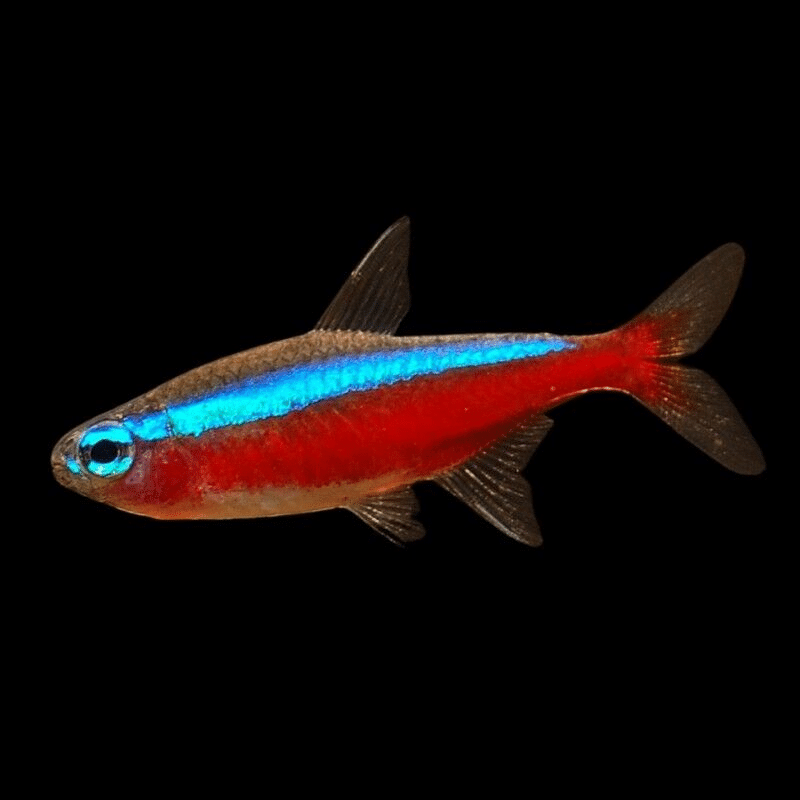
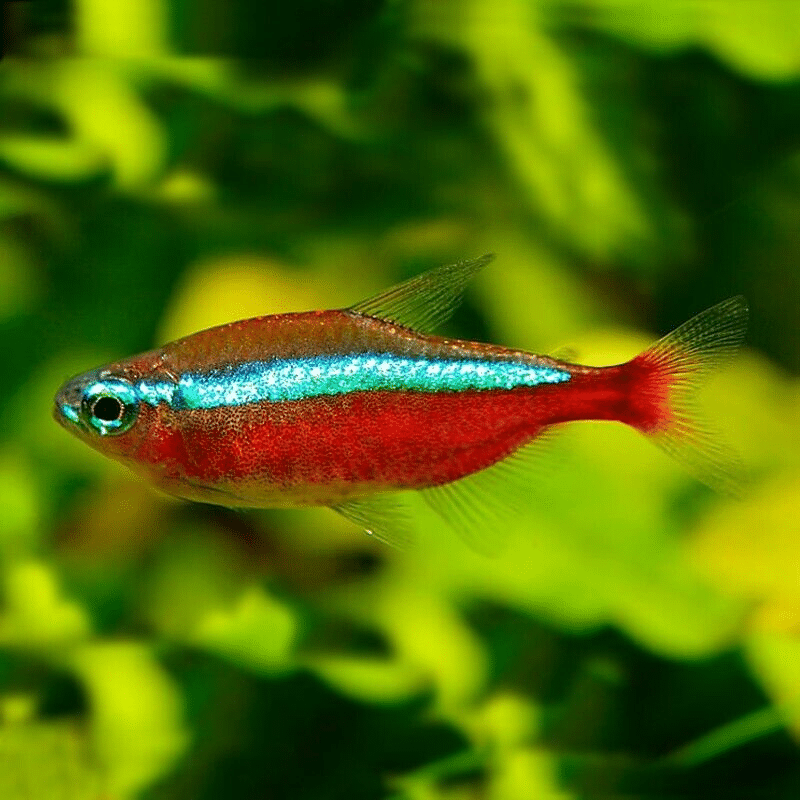






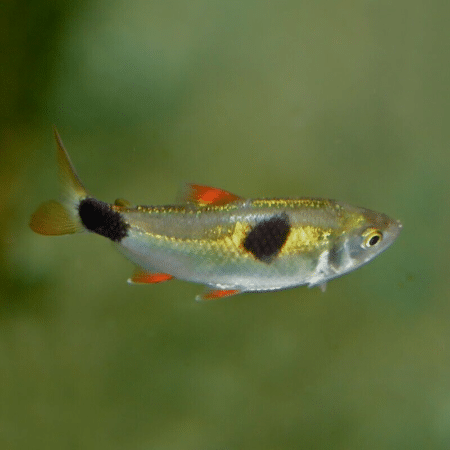



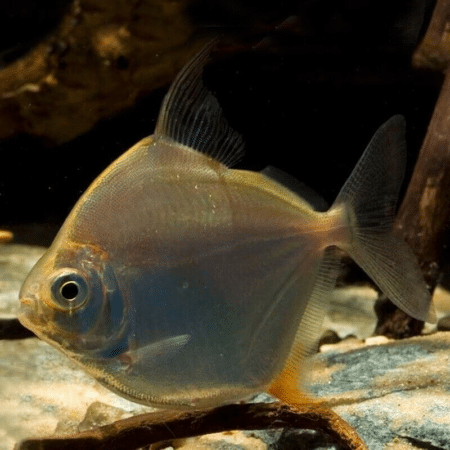
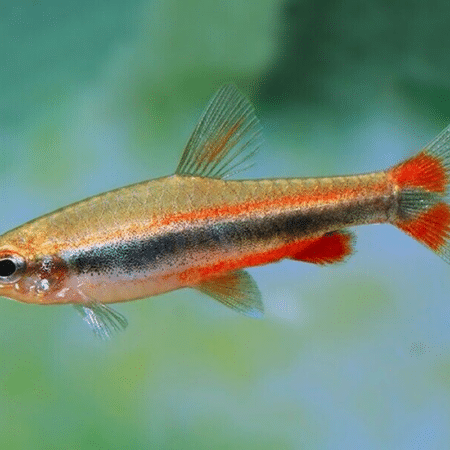




Emily Thompson (verified owner) –
I’ve been an aquarium hobbyist for over five years, and I recently decided to add 50 Cardinal Tetras (Paracheirodon axelrodi) to my community tank. After about two months of observing them, I couldn’t be happier! These dazzling little fish bring a vibrant splash of color with their striking blue and red hues, and they have such lively personalities!
What I love most is how peaceful and social they are; they thrive in schools and have really brought my tank to life. I feed them a mix of high-quality flakes and some frozen foods, and they’ve been healthy and active. Compared to neon tetras, which I’ve also kept, the Cardinal Tetras are slightly larger and have more vivid coloration, making them a stunning addition to any setup.
One minor concern is that they can be sensitive to water quality, so I recommend investing in a good filter and being diligent with water changes. But with proper care, they flourish! I highly recommend these beautiful fish to anyone looking to enhance their aquarium. They are perfect for beginners and experienced aquarists alike. It’s been a joy to watch them swim gracefully around—definitely worth every penny!
Laura Benson (verified owner) –
I’ve been keeping tropical fish for over 5 years, and I recently decided to add 50 Cardinal Tetras to my peaceful community aquarium. It’s been about two months since I introduced them, and I couldn’t be happier! These stunning neon tetras are not only beautiful with their vibrant blue and red colors, but they also add such a lively dynamic to my tank. I love watching them school together; their synchronized swimming is mesmerizing!
What truly stands out is how easy they are to care for compared to other small fish I’ve kept. They acclimated quickly and have shown no signs of stress. My water parameters have remained stable, and their health is evident in their bright coloration and active behavior. One minor note is to ensure they have plenty of hiding spots because they definitely appreciate some cover, especially when feeling shy.
For anyone considering adding these gorgeous fish to their aquarium, I wholeheartedly recommend them—especially for beginners or anyone with a community tank! They thrive in groups, so getting a sizable school is essential. Shipping was quick, and they arrived healthy and happy. These cardinal tetras have definitely brightened up my aquarium experience!
Emily Thompson (verified owner) –
I recently added 50 Cardinal Tetras to my community tank, and I couldn’t be happier! After about a month of watching them thrive, I can confidently say these little guys are a perfect addition. Their vibrant blue and red colors create a stunning display, especially when they school together—it’s mesmerizing.
I appreciate how peaceful they are, making them ideal companions for my other fish. Unlike some other neon tetras I’ve kept in the past, these Cardinal Tetras seem more robust and active, which I believe comes from their healthy shipping conditions. They arrived promptly and showed no signs of stress, which is always a relief.
A little tip for new buyers: ensure your tank is well-planted with hiding spots; it really helps them feel secure!
Overall, I highly recommend Cardinal Tetras for anyone looking to add beauty and liveliness to their aquarium. They’re not just neon tetras; they’re a delightful reflection of life in the water! I will definitely buy from this seller again.